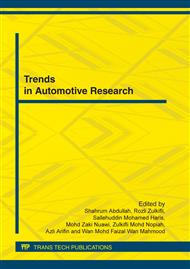[1]
N. Abdalla, R. O.K.R. Atiq and I. Amiruddin: Journal of Social Sciences Vol 3: 3 (2007), p.117.
Google Scholar
[2]
H. Kang and M.K. Abdul Jalil, M. M. (2004). Development of a Virtual Driving Simulator for Transportation Research. 1st International Conference on Product Design and Development (2004).
Google Scholar
[3]
R.W. Allen T.J. Rosenthal and M.L. Cook, in: A Short History of Driving Simulation, edited by D. L. Fisher, M. Rizzo, J. K. Caird and J. D. Lee, Handbook of Driving Simulation For Engineering, Medicine and Psychology, Boca Raton: CRC Press (2011).
DOI: 10.1201/b10836-3
Google Scholar
[4]
Blana, E: Driving Simulator Validation Studies: A Literature Review (Institute of Transport Studies, University of Leeds 1996).
Google Scholar
[5]
Jamson, H. Cross-Platform Validation Issues. In edited by D. L. Fisher, M. Rizzo, J. K. Caird and J. D. Lee, Handbook of Driving Simulation For Engineering, Medicine and Psychology, Boca Raton: CRC Press (2011).
Google Scholar
[6]
Information on http: /whqlibdoc. who. int/publications/2007/9241595116_eng. pdf.
Google Scholar
[7]
Royal Malaysian Police (2011).
Google Scholar
[8]
J. Edquist, T. Horberry, S. Hosking and I. Johnston: Applied Ergonomics Vol. 42(4) (2011), p.619.
DOI: 10.1016/j.apergo.2010.08.013
Google Scholar
[9]
E. Mazzae, T. Ranney, G. Watson and J. Wightman: Hand-Held or Hands-Free? The Effects of Wireless Phone Interactive Typ On Phone Task Performance and Driver Preference.
DOI: 10.1037/e624102011-001
Google Scholar
[10]
D. Fisher, A.P. Pollatsek, and A, Pradhan. Injury Prevention (2006), p. i25.
Google Scholar
[11]
K. Ball and M. Ackerman, in: The Older Driver(Training and Assessment: Knowledge, Skills and Attitudes), edited by D. L. Fisher, M. Rizzo, J. K. Caird and J. D. Lee, Handbook of Driving Simulation For Engineering, Medicine and Psychology, Boca Raton: CRC Press (2011).
DOI: 10.1201/b10836-26
Google Scholar
[12]
Information on http: /www. census. gov/population/www/projections/summarytables. html.
Google Scholar
[13]
R. Mat and H.M. Taha: 21st Population Census Conferences, Kyoto, Statistics Bureau and Statistics Center of Japan (2003), p.1.
Google Scholar
[14]
H.C. Lee, D. Cameron and A.H. Lee: Accident Analysis and Prevention Vol. 35 (2003), p.797.
Google Scholar
[15]
H.C. Lee, A.H. Lee,D. Cameron and C.L. Tsang: Journal of Safety Research Vol. 34, (2003), p.453.
Google Scholar
[16]
B. Reimer, B. Mehler, J. Son, A. Pohlmeyer, J. Orszulak, J. Long, J., et al: 5th International Driving Symposium on Human Factors in Driving Assessment, Training and Vehicle Design, Big Sky, Montana (2009), p.206.
DOI: 10.17077/drivingassessment.1323
Google Scholar
[17]
J.H. Wang, and M. Song: Proceeding of the Sixth Intenational Driving Symposium on Human Factors in Driver Assessment, Training and Vehicle Design, Olympic Valley, CA (2011), p.583.
Google Scholar
[18]
J. Biederman, R. Fried, M.C. Monuteaux, B. Reimer, J.F. Coughlin, C.B. Surman, M. Aleardi, M. Dougherty, S. Schoenfeld T.J. Spencer and S.V. Faraone: A Laboratory Driving Simulation For Assessment of Driving Behavior in Adults with ADHD: a Controlled Study. Annals of General Psychiatry Vol. 6(4) (2007).
DOI: 10.1186/1744-859x-6-4
Google Scholar
[19]
S.B. SzeSeen Kee: Global Journal of Health Science (2010), p.167.
Google Scholar
[20]
E. Zeeb: Driving Simulation Conference Europe 2010, Paris: INRETS, (2010), p.157.
Google Scholar
[21]
A. Kemeny: Driving Simulation for Virtual Testing and Perception Studies. Proceeding DSC 2009 Europe – Monaco (2009).
Google Scholar
[22]
S. Azzi, G. Reymond, F. Merienne, and A. Kemeny: Driving Simulation Conference Europe 2010, Paris: INRETS (2010), p.181.
Google Scholar
[23]
R. Fuller, in: Driver training and assessment: implications of the task-difficulty homeostasis model, edited by L. Dorn, volume III of Driver behaviour and training, Proceedings of the Third International Conference on Driver Behaviour and Training, Ashgate, Aldershot (2008).
DOI: 10.4324/9781315257372
Google Scholar
[24]
V.K. Pollatsek in: Driving Simulators as Training and Evaluation Tools: Novice Drivers, edited by D. L. Fisher, M. Rizzo, J. K. Caird and J. D. Lee, Handbook of Driving Simulation For Engineering, Medicine and Psychology, Boca Raton: CRC Press (2011).
DOI: 10.1201/b10836-31
Google Scholar
[25]
SWOV. Simulators in driver training. SWOV Fact Sheet. Leidschendam, the Netherlands: SWOV (2010).
Google Scholar
[26]
J. Caird and W. Horrey in: Twelve Practical and Useful Questions About Driving Simulation, edited by D. L. Fisher, M. Rizzo, J. K. Caird and J. D. Lee, Handbook of Driving Simulation For Engineering, Medicine and Psychology, Boca Raton: CRC Press (2011).
DOI: 10.1201/b10836-6
Google Scholar
[27]
S. Nichols and H. Patel: Applied Ergonomics Vol. 33, (2002), p.251.
Google Scholar
[28]
R.S. Kennedy and L.H. Frank. A Review of Motion Sickness with Special Reference to Simulator Sickness (Florida: Naval Training Equipment Center 1985).
DOI: 10.21236/ada155975
Google Scholar
[29]
J.J. La Viola Jr. : SIGCHI Bulletin Vol. 32(1) (2000), p.47.
Google Scholar
[30]
S. Cobb, S. Nichols, A. Ramsey and J. Wilson: Presence 8 (2) (1999), p.169.
Google Scholar
[31]
J.O. Brooks, R.R. Goodenough, M.C. Crisler, N.D. Klein, R.L. Alley, B.L. Koon, W. C. Logan Jr., J. H. Ogle, R. A. Tyrrell, R. F. Wills: Accident Analysis and Prevention Vol. 42(3), (2010). p.788.
DOI: 10.1016/j.aap.2009.04.013
Google Scholar
[32]
R.I. Mohd Salleh Abdul Ghani: Determination of Driver Drowsiness and Relevant Inidicative Parameters: A preliminary Laboratory Driving Simulation Study, Bangi: UKM (2005).
Google Scholar
[33]
M.J. Ruzelita Ngadiran: Measurement of Driver's Alertness Using and Automotive Simulator, Bangi: UKM (2007).
Google Scholar
[34]
R.I. Yohan Kurniawan: Utilization of Pungent Smell in Driver's Alert System: An Experimental Study on Malaysian Male Driver, Bangi: UKM (2007).
Google Scholar
[35]
Information on http: /www. fkm. utm. my/~kasim/content/motionbase. pdf.
Google Scholar
[36]
Information on http: /www. kpd. mil. my.
Google Scholar


